In today's extremely overpriced used truck market, many shoppers are now looking for "older" models that have aged well as a way to save significant dollars.
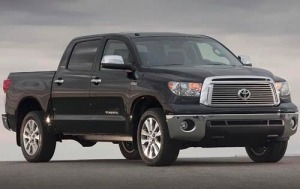
And the Toyota Tundra is certainly one of these models due to a strong record of reliability and durability. This makes them a viable and definitely more economical option in today's high-priced market.
History has demonstrated that a well-cared for Tundra can be expected to last in the 200,000 - 250,000 mile range before getting to the more expensive types of repairs. And reaching 300,000 miles is not that uncommon.
But the essential ingredient, apart from being a Toyota, is the "well-cared" for part. Without proper maintenance, all bets for longevity are off.
Still, while considered an excellent choice for reliability, some older Tundras can indeed have some problems, as all vehicles do.
So, here ...
- We'll do an overview of the first and second generation Tundras, produced from 2000 - 2021. However, we're really focusing on those roughly 10 or more years-old.
- Then we'll list possible mechanical issues that have been reported by owners of these older Tundras so they can be checked before buying one today.
- And then we'll summarize the overall pros and cons of an older Toyota Tundra worth consideration by potential buyers.
But first, and very importantly ...
Things To Do When Considering An "Older" Vehicle
Locate Lower Mileage Vehicles: They are certainly out there to be found with careful and patient shopping. Be willing to drive a distance if you have to.
Vehicle History and Maintenance: Ask for the vehicle history report (CarFax or AutoCheck) as well as documented maintenance and repair records. If not provided by the Dealer or private seller, it's usually best to move on.
Pre-Purchase Inspection: Have the vehicle independently inspected before making a final decision. This usually will cost in the $200 range but is well worth it given the potentially thousands in savings over the long term.
And My #1 Price Tip: It's important to get online price quotes at auto sites such as Edmunds.com and CarsDirect.com (both, actually), whether looking for a new or used car. Competition among dealers for your business is what gets you a lower price, and it's very easy.
And quickly, while we're at it, my #2 Tip is to always know the up-to-date trade-in value of your current car. You can get a quick and surprisingly accurate one at Edmund's Trade-In Quotes.
It's free and just takes a couple of minutes. I think what helps its accuracy is the inputs will include either your plate# or VIN# followed by many simple, but specific, yes/no questions. It really focuses in on the detail of the specific vehicle.
Second Generation Toyota Tundra (2007 - 2021)
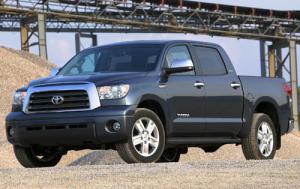
There's just no doubt that the Tundra is one good truck. We've driven a number of them over the years and we've always been more than impressed.
In fact, if there was a rap on the Tundra, it was that it was TOO smooth and comfortable, and not up to the "heavy lifting" and hard day-to-day work ethic of the American mainstays such as the Ford F-150 and Dodge Ram.
Well, all that changed beginning with the 2007 Tundra. This version features a fully boxed frame, three different cab sizes and bed lengths, and your pick of three engines.
And across the board, this Toyota Tundra then sttod on equal or higher ground with the other competing half-ton pickups. Actually, in terms of power, it became second only to the 403 horsepower V8 in the Cadillac Escalade EXT, as compared to the Tundra's available 381 horsepower V8.
"Three" seems to be the magic number when choosing an older Tundra. There's also three wheelbases and three trim levels. Three-passenger two door regular cabs come as either the basic DX model or more uplevel SR5 trim.
Both the Double Cab and longer CrewMax crew cab seat six, have four doors, and can be found in SR5 and top-of-the-line Limited models.
The other engines were retained from pre-2007 Tundra models and include a 236 horsepower V6 (standard in regular and Double cabs) and a 271 horsepower 4.7-liter V8 (standard in CrewMax trucks and optional in regular and Double cabs).
Safety features for all of this generation Tundras include antilock all-disc brakes, traction control, anti-skid control, front side airbags, and curtain side airbags that cover both seating rows and include rollover deployment.
The popular Limited models have leather upholstery and some can be found with the optional 20-inch wheels, as opposed to the standard 18s. CrewMax models have a power rear-cab window and some can be found with the optional DVD entertainment system.
Some of these older Tundras can also be found from time to time with the off-road package and a navigation system with a rearview camera that shows the trailer hitch.
Shoppers should note that the 4.6-liter V8 was upgraded to 310 horsepower for 2010. The 2010 model year also introduced two new trim levels, Platinum and Work Truck, as well as some minor cosmetic revisions and the addition of front-seat knee airbags.
The 2011 model year brought in a more powerful V6 engine with 270 horses.
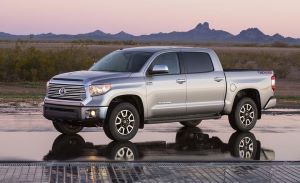
And in 2014, there was another facelist that ran until a third second-gen facelist in 2019 that carried through the 2021 model. (It should be noted that this last facelift is not covered here as it doesn't fall into the 10+ year-old category.)
The 2014 faceflift was both inside and out. It added a larger grille, sharper fenders, and new tail lights, while the interior was also significantly upgraded with a new steering wheel, infotainment display, gauge cluster, and seats.
The base 4.0-liter V-6 was boosted with an additional 34 horsepower, increasing output to 270, nearly as robust as the very first 4.7-liter V-8 Tundra in 2000.
It was also the first in its class with a standard backup camera on all models, as well as the first to offer a Blind Spot Monitor with Rear Cross Traffic Alert (Platinum and 1794 Edition).
2007 - 2018 Toyota Tundra Possible Mechanical Problems
The second-generation Tundra, while generally quite reliable, did have some mechanical issues reported by some owners. And while they varied in severity and occurrence, they should definitely be included in a pre-purchase inspection.
Exhaust Manifold Cracks: Some second generation Tundras experienced issues with exhaust manifold cracks, particularly in models equipped with the 5.7-liter V8 engine. This could lead to exhaust leaks, increased engine noise, and potentially decreased performance.
Rear Differential Failure: Some owners reported problems with the rear differential, including leaks, noise, or complete failure.
Car Buying Tips:
How to Negotiate Low New Car Prices
How To Get The Best Trade-In Price
Camshaft Tower Seal Leak: Oil leaks from the camshaft tower seals were reported by some owners, particularly in Tundras equipped with the 5.7-liter V8 engine.
Transmission Shifting Issues: Some owners experienced transmission-related problems, such as rough shifting, hesitation, or slipping gears.
Brake Problems: Some owners reported premature wear of brake components, including brake pads, rotors, and calipers.
Water Pump Failure: Water pump failure was reported by some owners, particularly in models equipped with the 5.7-liter V8 engine. This issue could lead to coolant leaks, engine overheating, and potential engine damage.
Timing Chain Tensioner Leak: Oil leaks from the timing chain tensioner were reported by some owners, particularly in Tundras equipped with the 4.6-liter V8 engine.
Steering Shaft Rattle: Some owners reported a rattling noise coming from the steering shaft, particularly during low-speed maneuvers.
It's important to note that while these issues were reported by some owners, they were not widespread, and many Tundras from this generation provided reliable performance with proper maintenance. Additionally, Toyota often issued recalls, technical service bulletins, or extended warranties to address some of these issues.
First Generation Toyota Tundra (2000 - 2006)
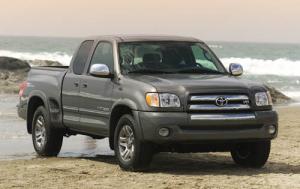
Although offered in several body styles and available with an optional V8, this version lacks some of the next generation's overall robustness when it comes to hard work chores, although its drive is smooth and comfortable.
Initially, these were produced in regular and extended-cab forms, with the reg-cab versions only offered with long beds and the extended-cab models (called the Access Cab) only offered with short beds. While the Access Cab did come with two rearward-opening doors, the backseat was on the tight side for a full-size pickup.
The three available models included a thinly equipped base, a midlevel SR5 and a top-level Limited. The base model was offered only with a regular cab and two-wheel-drive. The standard reg-cab engine was a 190-horsepower 3.4-liter V6 that produced 220 lb-ft of torque. Available transmissions were a 5-speed manual or 4-speed automatic.
Also available was a 245-horsepower 4.7-liter V8 that pumped out 315 lb-ft of torque. This engine was only paired with the 4-speed automatic.
In terms of significant changes during this production run, the Double Cab (crew-cab) made its debut for 2004. This was an important addition to the lineup, particularly for family-oriented buyers, because it rode on an extended wheelbase and offered a more spacious interior and the same cargo bed length as the Access Cab.
Older Tundra buyers who plan on a lot of cargo hauling and/or towing would likely be better off sticking to 2005 and newer models because their powertrains were upgraded at that time.
The standard engine became a 245-horsepower 4.0-liter V6 that was mated to either a 5-speed automatic transmission or a 6-speed manual. The output of the 4.7-liter V8 was also boosted to 282 horsepower and was paired exclusively to the 5-speed automatic.
2000 - 2006 Toyota Tundra Possible Mechanical Problems
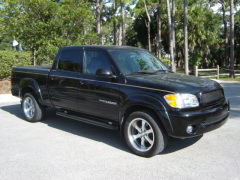
The first generation Toyota Tundra, while generally known for its reliability, did have a few common mechanical issues reported by owners that should therefore be included in an inspection before buying today.
Frame Rust: One of the most significant issues faced by some first generation owners was frame rust in some regions with harsh climates or heavy road salt usage, which could lead to structural integrity concerns.
Transmission Problems: Some owners reported transmission issues, such as rough shifting, slipping gears, or premature failure, particularly in Tundras equipped with the V8 engine.
Brake Problems: Brake-related issues, including premature wear of brake pads and rotors, were reported by some Tundra owners.
Ball Joint Wear: Premature wear of the front suspension ball joints was reported by some owners. This could lead to handling issues, uneven tire wear, and potentially dangerous driving conditions.
Exhaust Manifold Cracks: Cracks in the exhaust manifold were reported by some owners, particularly in Tundras equipped with the V8 engine. This issue could lead to exhaust leaks, increased engine noise, and potentially decreased performance.
Fuel Pump Failure: Some owners experienced fuel pump failure, leading to engine stalling or difficulty starting the vehicle.
Timing Belt Tensioner Failure: In some cases, the timing belt tensioner failed prematurely, leading to timing belt slippage or failure. This could result in severe engine damage if not addressed promptly.
It's again important to note that while these issues were reported by some owners, they weren't universal. Additionally, Toyota often issued recalls or extended warranties to address some of these issues. Check the maintenance records of any vehicle you are considering for these repairs.
Overall Older Toyota Tundra Pros And Cons
Older Tundra Pros
Reliability: Toyota Tundras, especially older models, have a reputation for being very reliable vehicles overall. They're known for their longevity and ability to withstand high mileage with minimal issues.
Lower Purchase Price: Obviously, older Tundras generally have lower purchase prices compared to new vehicles, allowing buyers to save money upfront.

Lower Depreciation: Since older vehicles have already experienced the majority of their depreciation, buyers can avoid the steep initial drop in value that occurs with newer cars. This can result in better long-term value retention and potentially lower ownership costs.
Availability of Parts and Aftermarket Support: Given the popularity of the Toyota Tundra, parts and aftermarket support are generally widely available. This can make maintenance and repairs more accessible and potentially less expensive compared to less common or imported vehicles.
Powerful Engine Options: The Tundra offers a range of potent engine options, including a powerful 5.7-liter V8, providing excellent towing and hauling capabilities for its class.
Spacious and Comfortable Interior: The Tundra's cabin is spacious and well-appointed, with comfortable seating and high-quality materials, offering a pleasant driving experience for both passengers and drivers.
Advanced Technology Features: The second-generation Tundra was equipped with a range of advanced technology features, including a touchscreen infotainment system, smartphone integration, available navigation, and advanced safety features like blind-spot monitoring and rear cross-traffic alert.
Impressive Towing and Hauling Capacities: With its robust construction and powerful engine options, the Tundra has impressive towing and hauling capabilities, making it well-suited for demanding tasks and work-related activities.
Comfortable Ride: The Tundra had a comfortable and relatively smooth ride compared to some of its competitors, making it suitable for daily driving and long trips.
More Car Buying Tips:
This One Tip Will Save Thousands On Car Insurance
The Best Gas Mileage Used Cars
Resale Value: Due to its reputation for reliability and durability, the Tundra typically holds its value well over time, lowering its overall cost of ownership if resold.
Older Tundra Cons
Higher Maintenance Costs: While Tundras are generally reliable, older vehicles may require more frequent maintenance and repairs compared to newer models, potentially offsetting some of the advantage of lower upfront costs.
Fuel Economy: Older Tundras, particularly those equipped with larger V8 engines, may have lower fuel economy compared to newer, more fuel-efficient vehicles.
Limited Features and Technology: Older Tundras, particularly the first generation, may lack some of the modern features and technology found in newer vehicles. This could include advanced safety features, infotainment systems, and convenience features that enhance the driving experience.
Safety Considerations: While older Tundras may have been safe when they were originally produced, they may not offer the same level of safety features and crash protection as newer vehicles.
Stiff Ride Quality: Some owners noted that the ride quality could feel stiff or jarring, especially over rough roads or when unloaded, which may affect comfort for passengers.
Limited Cab and Bed Configurations: The Tundra offered a somewhat limited range of cab and bed configurations compared to some of its competitors, which may not fully meet the diverse needs of all buyers.
Outdated Design: While the Tundra received updates throughout its production run, its basic design remained largely unchanged over its lifespan, leading some critics to perceive it as outdated compared to more recently redesigned competitors.
Towing Capacity: While the Tundra's towing capacity was competitive within its class, it wasn't as high as some of its rivals, which may be a drawback for those needing to tow heavier loads.
Interior Space: The Tundra's interior space, especially in the Access Cab configuration, was not as generous as some of its competitors, which may be a concern for families or those needing more passenger space.
 By Josh Rosenberg
By Josh Rosenberg